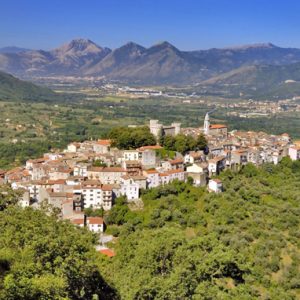
Molise
This small and beautiful region is outside the tourist paths. Campobasso is the capital of Molise. It once produced swords and blades and now the industry has changed and it now produces knives and scissors. The town of Termoli, the largest seaside resort in Molise, provides for the mostly Italian vacationers, a favorite summer destination with its beautiful beaches, tourist attractions, historic artifacts and a hospitable and vibrant people.
The province of Isernia is in the mountainous area known for its unspoiled beauty and for the abundance of artifacts dating back to the Paleolithic era. The town of Agnone is famous for its artisan factory that produces bronze bells, forged by the Marinelli Foundry, established over one thousand years ago; it is the oldest in the world.
The food in Molise shares the traditional cooking of the neighboring regions as they share traditions and history but the diversity of the terrain produces extraordinary ingredients that give to the local cuisine its own personality.
In the hills of the west region, smoked and cured prociutto, soppressate salami and sausages preserved in olive oil are produced and shipped to the European markets. From the sheep, goat and cow milk cheese is produced as scamorza, a pear-shaped young cheese, caciocavallo and pecorino.
The region produces olive oil famous since ancient times and the Colavita family exports the extra vergine to the U.S.A.
The gastronomy of the region is based on fresh vegetables, cheeses and soups made with chickpeas, beans and the plentiful lentils cultivated in the area. Cauliflower and asparagus are eaten fresh from the fields, simply boiled and sprinkled with olive oil and lemon. Eggplants are baked in a mold with cheese, other vegetables, herbs and spices: so delicious and fulfilling that it can be served as an entrée or a side dish.
The white truffles, tartufi bianchi, that germinate only in Molise and Piedmont, are used to makebruschetta and to grate over pasta or risotto, the dark truffles, tartufi neri, are grated and used in cooking for their strong flavor.
An antipasto offered in one of my trips to Molise consisted of bruschetta with tartufi bianchi, an assortment of cheeses, the manteche, smoked scamorza stuffed with butter, various kinds of salamiand the best soppressate I ever tasted; the piccellate, some sort of slightly sweet pizzette, were served with the antipasto.
The calciuni, fried turnovers stuffed with ricotta, prociutto and cheese, are good for a snack or appetizer.
Suckling pig, the porchetta, is made roasted; muttons and lambs are the preferred meat. Pork is simply sautéed with the tasty local olive oil, onions, garlic and scented with the delicate marjoram, the oregano-like herb. To make coniglio ripieno, rabbits are marinated overnight in wine and vinegar, stuffed with chopped veal, herbs and spices, and baked slowly. The easy to make coniglio alla Molisana-rabbit Molise style is stewed with potatoes, sausages and diavolini, the hot chili red pepper.
The wild boar is marinated for a few days in red wine and various vegetables, after being larded with garlic and black pepper; then it is sautéed in olive oil and wine and baked for a few hours with the juices of the marinade and some tomato sauce. Lamb is stewed in wine and tomato and served with roasted peppers: the sauce is used for the pasta, usually the cavatelli. Sausages, poultry and game are stewed, baked or made on the spit.
In Campobasso, the caponata is a local typical dish different from the Sicilian Caponata. It is made with all wheat crackers called taralli softened in vinegar and water, sprinkled with a mixture of stewed chopped tomato, onions, celery, anchovies, olives, abundant olive oil and covered with hard-boiled eggs. Baccala’, the salted codfish, is cooked with garlic, peppers, onions, raisins, cappers and olives; the baccala’ natalizio is salted cod with celery, parsley, walnuts, chestnuts and white wine.
In the sea coast, the red mullets, anchovies, swordfish, calamari and frutti di mare supply the basic ingredients to fine fish dishes and their famous soups.
In the region, there are numerous factories that produce dry, excellent quality pasta, exported worldwide and available in the U.S.A.’s supermarkets.
The pasta dishes produced are many and the meat sauce made with lamb or pork is preferred. Cif e ciaf is a specialty made with chunks of pork meat sautéed with carrot, onion, celery and peperoncino– hot pepper- and wine, then slowly cooked with tomato sauce; the sauce is a robust and spicy pasta condiment.
Pasta is also made with vegetables or fresh legumes in season and served with pecorino cheese and lots of peperoncino, chili pepper. The chili pepper, also called diavolini, is used extensively as a condiment, as a therapy for many sicknesses and as a remedy against the evil eye….
Wines are produced and consumed locally. Biferno red and Pentro di Isernia and Molise DOC are few of the well-known wines of Molise.
Among the many homemade desserts there is the sanguinaccio, pig’s blood with honey, raisins, candied orange peels and the calzone a fried turnover shaped pasty, stuffed with boiled and pureed chickpeas. A deluxe version is made with the addition of cinnamon, candied orange or lemon peels and sweetened with honey. At Christmas cocoa and local liquor is added. In season pureed chestnuts replace the chickpeas.
A baked dessert called picallati or colac is like a turnover in the half moon shape, it is made with pasta frolla – short dough- stuffed with wine must, honey, nuts, figs, apples, candied orange peels, cinnamon and cloves.
The circerchiata are small honey balls made for Christmas, and for Easter the picillato, sweet bread made with flour and potatoes and the half moon shaped casciatelli made with flaky and delicate dough and stuffed with a cream made with ricotta, sugar, cinnamon and candied diced fruits.
